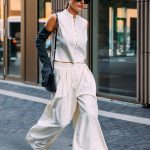One goes to Sunnei’s shows with feelings of anticipation bordering on anxiety. Knowing that the interaction of the audience to their performances is part of the game, one doesn’t know what to expect. They keep us on our toes. So far, we’ve never been disappointed, anxiety notwithstanding. They’ve been quite consistently brilliant.
This time we had to trek to a desolate, uninspiring television studio in the middle of nowhere, where, after taking our seats in a cavernous theater as if we were to participate to a cheap reality show, we were handed numbered paddles, and asked to rate each of the outfits of the fashion show. While we waited in the dark space, we were entertained by a rather disquieting recorded voice blasting out messages, sort of aphorisms à la Sunnei: “Expressing your opinion feels great, do it now!” Or, “This time you’ll be more than just a part of the show’s set design!”
Simone Rizzo and Loris Messina use fashion as social commentary; they do it with a sharp, almost ferocious wit that is utterly endearing. “We start from the urge we feel to unravel paradoxes, translating that into artistic gestures,” said Rizzo. Here, demystifying the destructive power of media was on the agenda. “Everyone has an opinion, everyone is a judge, an advocate, a writer, a reviewer, and there’s a widespread blah blah, (and the idea that) all opinions are legit regardless of whether they’re grounded in knowledge,” chimed in Messina. So they give the audience permission to unleash their murderous inner fashion critic. “SUNNEI is the opportunity to not hate fashion, ANCORA!” admonished the booming voice. “Having an opinion is natural, just release it! Follow your guts! Don’t overthink, just judge!”
The collection certainly scored high. The pace was fast, focused; the looks were reduced to just 30: “We already have too much information in the world,” stated Messina. If only more designers listened, fashion would be a much healthier place instead of being perennially overstuffed. What the Sunneis sent out was a concise proposition that riffed on their best-ofs— exaggerated volumes they called Maxi Over pitted against slender silhouettes in the Ultra Stretch category.
Surfaces were treated with a textural approach; rubber was re-used from bags’ leftovers; layering was consistent with the practical need for protection. Illusionistic effects were as inventive as they were disquieting, as in a dress in sheer organza, onto which the scanned image of a naked body was 3D printed. Subsequently an entire look—underwear, a pair of trousers, a shirt—was also scanned and printed onto separate layers of organza, which were then assembled into a sort of mille-feuille dress. Making it must have been labor-intensive: the dress took looked like a pretty amazing specimen of next-level trompe-l’oeil.
Speaking about their creative mindset, Messina said: “We’re becoming more and more introspective in how we relate to our work. We continuously revisit, hone, and perfect what we’ve done since the beginning.” The designers are quiet, obsessive radicals. “There’s no middle ground,” they said in unison.



